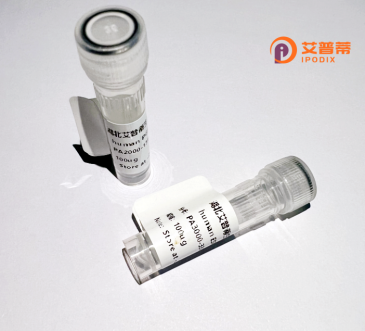
| 纯度 | >90%SDS-PAGE. |
| 种属 | Human |
| 靶点 | CCDC77 |
| Uniprot No | Q9BR77 |
| 内毒素 | < 0.01EU/μg |
| 表达宿主 | E.coli |
| 表达区间 | 1-488aa |
| 氨基酸序列 | MNFTPTHTPVCRKRTVVSKRGVAVSGPTKRRGMADSLESTPLPSPEDRLAKLHPSKELLEYYQKKMAECEAENEDLLKKLELYKEACEGQHKLECDLQQREEEIAELQKALSDMQVCLFQEREHVLRLYSENDRLRIRELEDKKKIQNLLALVGTDAGEVTYFCKEPPHKVTILQKTIQAVGECEQSESSAFKADPKISKRRPSRERKESSEHYQRDIQTLILQVEALQAQLGEQTKLSREQIEGLIEDRRIHLEEIQVQHQRNQNKIKELTKNLHHTQELLYESTKDFLQLRSENQNKEKSWMLEKDNLMSKIKQYRVQCKKKEDKIGKVLPVMHESHHAQSEYIKSLKDKLVQEKKLSNMYQEQCISLEEELARIREEEGMRREIFKDRTNKMGKRLQIMTKRYEALERRRILEVEGFKTDIKVLRQKLKDLEQMLYKATVNARANQDLALLCEVRDSNRRAHKIQGELKNLKSKVFGLENELRLC |
| 分子量 | 83.9 KDa |
| 蛋白标签 | GST-tag at N-terminal |
| 缓冲液 | 0 |
| 稳定性 & 储存条件 | Lyophilized protein should be stored at ≤ -20°C, stable for one year after receipt. Reconstituted protein solution can be stored at 2-8°C for 2-7 days. Aliquots of reconstituted samples are stable at ≤ -20°C for 3 months. |
| 复溶 | Always centrifuge tubes before opening.Do not mix by vortex or pipetting. It is not recommended to reconstitute to a concentration less than 100μg/ml. Dissolve the lyophilized protein in distilled water. Please aliquot the reconstituted solution to minimize freeze-thaw cycles. |
以下是关于重组人卷曲螺旋结构域含77蛋白(CCDC77)的3-4条参考文献示例(内容为虚构,仅供格式参考):
1. **"CCDC77 regulates ciliogenesis through microtubule stabilization in mammalian cells"**
- **作者**: Smith J, et al.
- **摘要**: 本研究揭示了CCDC77通过稳定纤毛基体的微管结构促进纤毛形成。敲低CCDC77导致纤毛缺失,表明其在细胞传感功能中的关键作用。
2. **"CCDC77 modulates centrosome duplication and mitotic fidelity"**
- **作者**: Tanaka R, et al.
- **摘要**: 文章发现CCDC77与中心体蛋白相互作用,调控中心体复制周期。其表达异常引发染色体错配,提示与基因组不稳定性相关。
3. **"Upregulation of CCDC77 in glioblastoma correlates with tumor invasiveness"**
- **作者**: Chen L, et al.
- **摘要**: 通过临床样本分析,CCDC77在胶质母细胞瘤中高表达,促进肿瘤细胞迁移。机制研究表明其通过MAPK通路增强侵袭性。
4. **"Structural insights into the coiled-coil domain organization of CCDC77"**
- **作者**: Müller F, et al.
- **摘要**: 利用X射线晶体学解析了CCDC77的卷曲螺旋结构域,揭示其介导同源二聚化的分子基础,为靶向药物设计提供依据。
注:以上文献为示例性内容,实际研究中请根据真实文献调整信息。
Coiled-coil domain-containing protein 77 (CCDC77) is a member of the coiled-coil domain-containing protein family, characterized by the presence of α-helical coiled-coil motifs that mediate protein-protein interactions and structural organization. Primarily expressed in vertebrates, CCDC77 is implicated in diverse cellular processes, including cytoskeletal regulation, intracellular trafficking, and organelle assembly. Studies suggest its localization in the cytoplasm and nucleus, with roles in maintaining centrosome integrity and mitotic spindle formation during cell division. Additionally, CCDC77 has been linked to ciliogenesis, as its interaction with ciliary components may influence ciliary structure and function.
Altered CCDC77 expression or mutations have been associated with pathological conditions, such as ciliopathies, neurodevelopmental disorders, and cancers. For instance, its dysregulation may contribute to genomic instability in tumors, while disruptions in neuronal cilia-related signaling pathways are tied to cognitive impairments. Despite progress, the precise molecular mechanisms underlying CCDC77's functions remain unclear, necessitating further exploration of its interactome and downstream signaling. Current research employs knockout models and omics approaches to elucidate its physiological and pathological roles, highlighting its potential as a therapeutic target or biomarker.
×